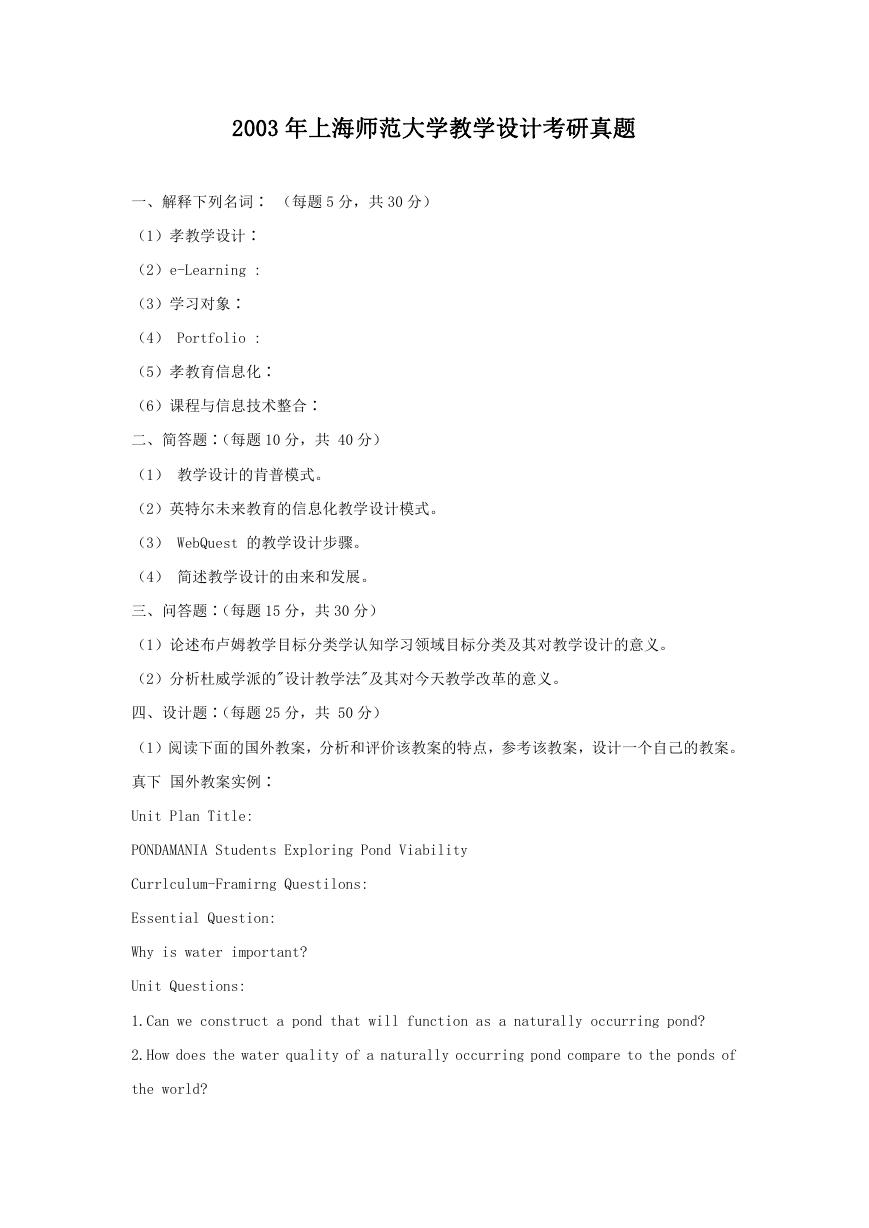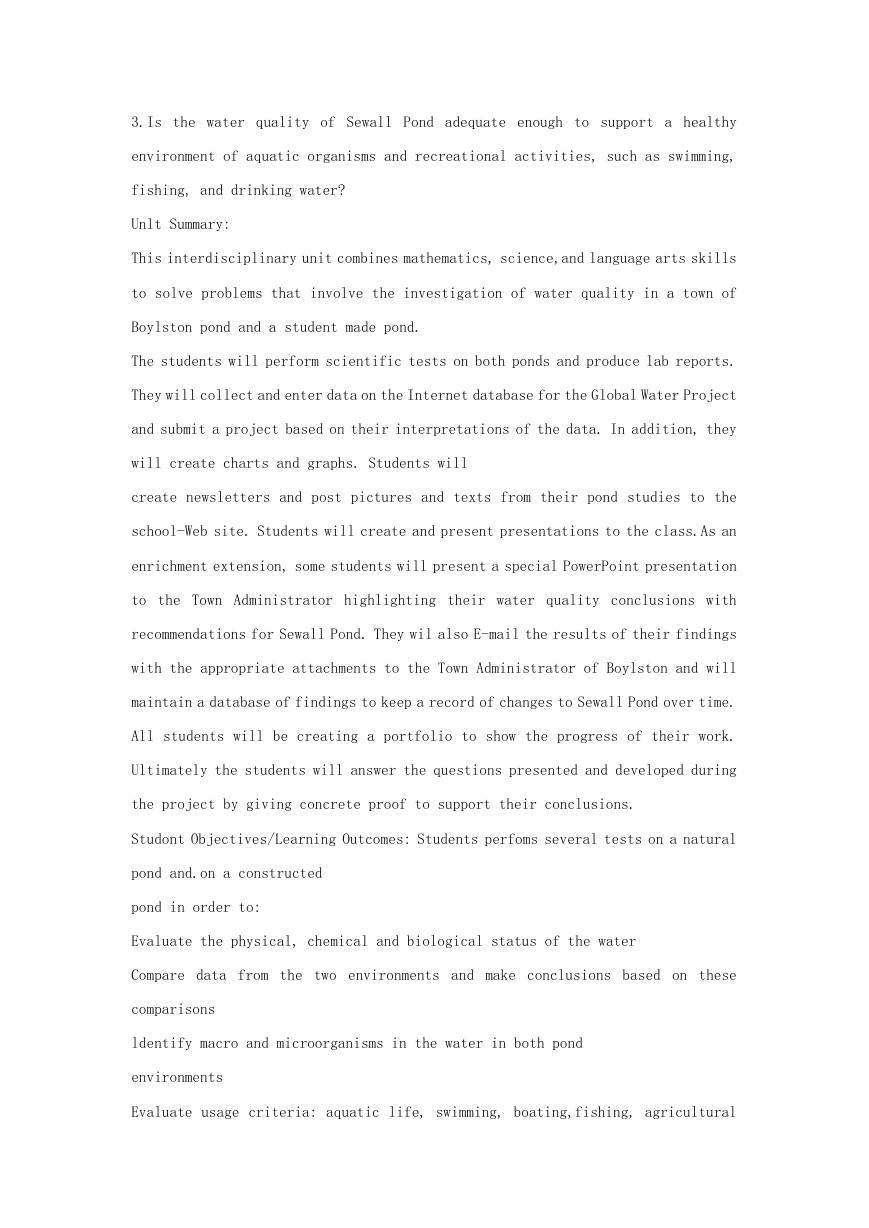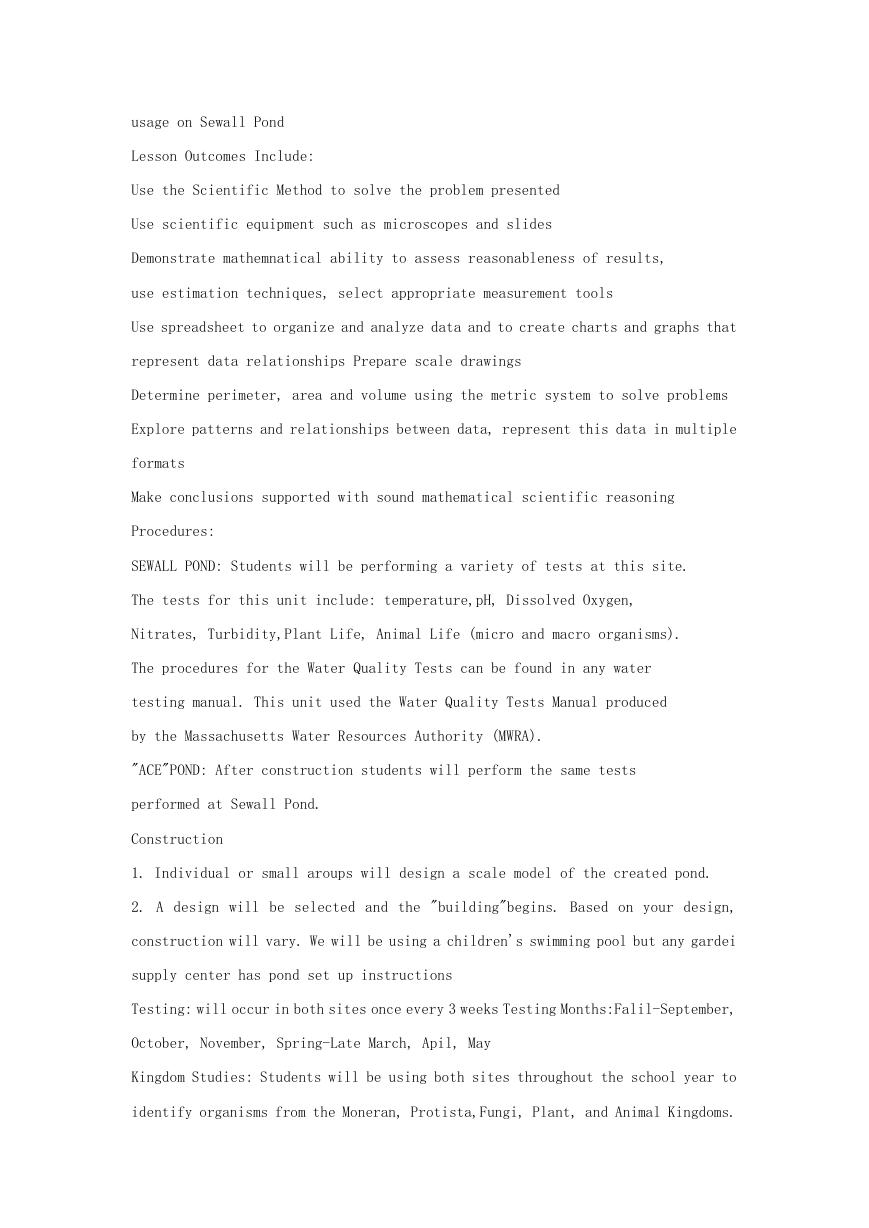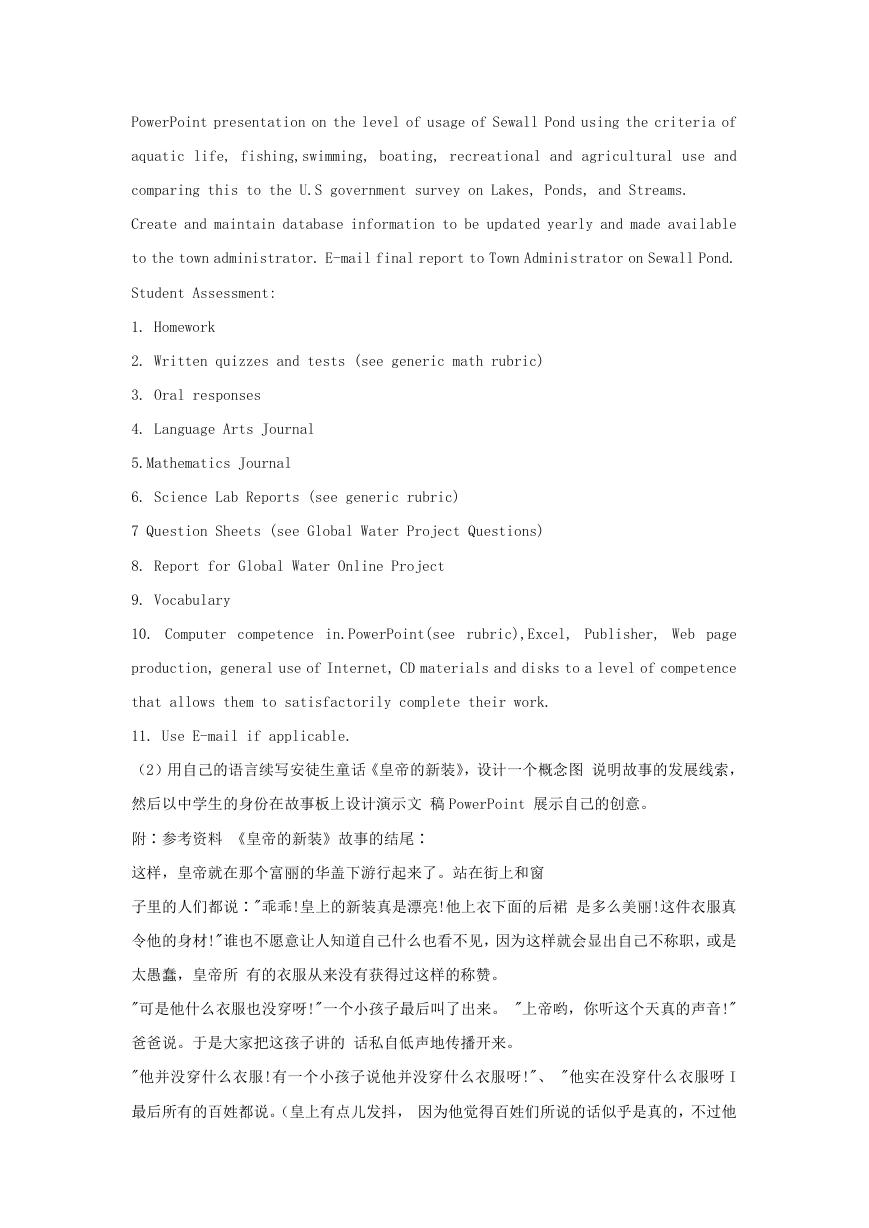2003 年上海师范大学教学设计考研真题
一、解释下列名词∶ (每题 5 分,共 30 分)
(1)孝教学设计∶
(2)e-Learning :
(3)学习对象∶
(4) Portfolio :
(5)孝教育信息化∶
(6)课程与信息技术整合∶
二、简答题∶(每题 10 分,共 40 分)
(1) 教学设计的肯普模式。
(2)英特尔未来教育的信息化教学设计模式。
(3) WebQuest 的教学设计步骤。
(4) 简述教学设计的由来和发展。
三、问答题∶(每题 15 分,共 30 分)
(1)论述布卢姆教学目标分类学认知学习领域目标分类及其对教学设计的意义。
(2)分析杜威学派的"设计教学法"及其对今天教学改革的意义。
四、设计题∶(每题 25 分,共 50 分)
(1)阅读下面的国外教案,分析和评价该教案的特点,参考该教案,设计一个自己的教案。
真下 国外教案实例∶
Unit Plan Title:
PONDAMANIA Students Exploring Pond Viability
Currlculum-Framirng Questilons:
Essential Question:
Why is water important?
Unit Questions:
1.Can we construct a pond that will function as a naturally occurring pond?
2.How does the water quality of a naturally occurring pond compare to the ponds of
the world?
�
3.Is the water quality of Sewall Pond adequate enough to support a healthy
environment of aquatic organisms and recreational activities, such as swimming,
fishing, and drinking water?
Unlt Summary:
This interdisciplinary unit combines mathematics, science,and language arts skills
to solve problems that involve the investigation of water quality in a town of
Boylston pond and a student made pond.
The students will perform scientific tests on both ponds and produce lab reports.
They will collect and enter data on the Internet database for the Global Water Project
and submit a project based on their interpretations of the data. In addition, they
will create charts and graphs. Students will
create newsletters and post pictures and texts from their pond studies to the
school-Web site. Students will create and present presentations to the class.As an
enrichment extension, some students will present a special PowerPoint presentation
to the Town Administrator highlighting their water quality conclusions with
recommendations for Sewall Pond. They wil also E-mail the results of their findings
with the appropriate attachments to the Town Administrator of Boylston and will
maintain a database of findings to keep a record of changes to Sewall Pond over time.
All students will be creating a portfolio to show the progress of their work.
Ultimately the students will answer the questions presented and developed during
the project by giving concrete proof to support their conclusions.
Studont Objectives/Learning Outcomes: Students perfoms several tests on a natural
pond and.on a constructed
pond in order to:
Evaluate the physical, chemical and biological status of the water
Compare data from the two environments and make conclusions based on these
comparisons
ldentify macro and microorganisms in the water in both pond
environments
Evaluate usage criteria: aquatic life, swimming, boating,fishing, agricultural
�
usage on Sewall Pond
Lesson Outcomes Include:
Use the Scientific Method to solve the problem presented
Use scientific equipment such as microscopes and slides
Demonstrate mathemnatical ability to assess reasonableness of results,
use estimation techniques, select appropriate measurement tools
Use spreadsheet to organize and analyze data and to create charts and graphs that
represent data relationships Prepare scale drawings
Determine perimeter, area and volume using the metric system to solve problems
Explore patterns and relationships between data, represent this data in multiple
formats
Make conclusions supported with sound mathematical scientific reasoning
Procedures:
SEWALL POND: Students will be performing a variety of tests at this site.
The tests for this unit include: temperature,pH, Dissolved Oxygen,
Nitrates, Turbidity,Plant Life, Animal Life (micro and macro organisms).
The procedures for the Water Quality Tests can be found in any water
testing manual. This unit used the Water Quality Tests Manual produced
by the Massachusetts Water Resources Authority (MWRA).
"ACE"POND: After construction students will perform the same tests
performed at Sewall Pond.
Construction
1. Individual or small aroups will design a scale model of the created pond.
2. A design will be selected and the "building"begins. Based on your design,
construction will vary. We will be using a children's swimming pool but any gardei
supply center has pond set up instructions
Testing: will occur in both sites once every 3 weeks Testing Months:Falil-September,
October, November, Spring-Late March, Apil, May
Kingdom Studies: Students will be using both sites throughout the school year to
identify organisms from the Moneran, Protista,Fungi, Plant, and Animal Kingdoms.
�
Mathematics classes:
Spreadsheets and Graphs: Students will be taught Excel basics.
Pond Design: Students will work with scale drawings. Wil also have an opportunity
to observe a CAD class.
Surveys: Will use Data Expiorer software.
Charts and Graphs: Study the use of graphs as communication. What type of graph to
use for best results.
Journal: Students wil use journals to explain the meaning of articles,graphs and
to answer questions.
Measurement: Perimeter, Area and Volume wil be taught in the curriculum.
Technology Skills:
The technology skills necessary to complete the project will be taught within various
classes with the assistance of the media specialist. Microsoft Excel: Taught in math
classes Internet: All classes with assistance from Media Specialist Microsoft
PowerPoint: Language Arts and Media Specialist Microsoft PublisherLanguage Arts and
Media Specialist Web site Construction: Math, Science and Language Arts classes CD:
Taught in Math, Science, and Library Electronic Media: Taught in Library
Approximate Time Needed:
This project will continue throughout the school year. Water testing will be in the
Fall and the Spring but other aspects such as research and microscope work will
continue throughout. The mathematics and Language Arts lessons will correspond
throughout the year as necessary to support the project Prerequisite Skills: 1. Basic
Mathematics, Science and Language Arts Skills 2. Lab Safety Skills 3. Some Computer
Literacy such as keyboarding, Word Processing and Internet inquiry
Accommodations for Differentiated Instruction: Resource Student:
Alpha Smart for all journal writing, lab reports,and question sheets E-reader for
Encarta and other research material when available
Modified Lab reports and procedures
Modified Quizzes and Tests Peer support and small group support during unit Gifted
Student:
�
PowerPoint presentation on the level of usage of Sewall Pond using the criteria of
aquatic life, fishing,swimming, boating, recreational and agricultural use and
comparing this to the U.S government survey on Lakes, Ponds, and Streams.
Create and maintain database information to be updated yearly and made available
to the town administrator. E-mail final report to Town Administrator on Sewall Pond.
Student Assessment:
1. Homework
2. Written quizzes and tests (see generic math rubric)
3. Oral responses
4. Language Arts Journal
5.Mathematics Journal
6. Science Lab Reports (see generic rubric)
7 Question Sheets (see Global Water Project Questions)
8. Report for Global Water Online Project
9. Vocabulary
10. Computer competence in.PowerPoint(see rubric),Excel, Publisher, Web page
production, general use of Internet, CD materials and disks to a level of competence
that allows them to satisfactorily complete their work.
11. Use E-mail if applicable.
(2)用自己的语言续写安徒生童话《皇帝的新装》,设计一个概念图 说明故事的发展线索,
然后以中学生的身份在故事板上设计演示文 稿 PowerPoint 展示自己的创意。
附∶参考资料 《皇帝的新装》故事的结尾∶
这样,皇帝就在那个富丽的华盖下游行起来了。站在街上和窗
子里的人们都说∶"乖乖!皇上的新装真是漂亮!他上衣下面的后裙 是多么美丽!这件衣服真
令他的身材!"谁也不愿意让人知道自己什么也看不见,因为这样就会显出自己不称职,或是
太愚蠢,皇帝所 有的衣服从来没有获得过这样的称赞。
"可是他什么衣服也没穿呀!"一个小孩子最后叫了出来。 "上帝哟,你听这个天真的声音!"
爸爸说。于是大家把这孩子讲的 话私自低声地传播开来。
"他并没穿什么衣服!有一个小孩子说他并没穿什么衣服呀!"、 "他实在没穿什么衣服呀 I
最后所有的百姓都说。(皇上有点儿发抖, 因为他觉得百姓们所说的话似乎是真的,不过他
�
心里却这样想∶"我必须把这游行大典举行完毕"因此他摆出一副更骄傲的神气。他的内臣 们
跟在他后面走,手中托着一条并不存在的后裙
�












 2023年江西萍乡中考道德与法治真题及答案.doc
2023年江西萍乡中考道德与法治真题及答案.doc 2012年重庆南川中考生物真题及答案.doc
2012年重庆南川中考生物真题及答案.doc 2013年江西师范大学地理学综合及文艺理论基础考研真题.doc
2013年江西师范大学地理学综合及文艺理论基础考研真题.doc 2020年四川甘孜小升初语文真题及答案I卷.doc
2020年四川甘孜小升初语文真题及答案I卷.doc 2020年注册岩土工程师专业基础考试真题及答案.doc
2020年注册岩土工程师专业基础考试真题及答案.doc 2023-2024学年福建省厦门市九年级上学期数学月考试题及答案.doc
2023-2024学年福建省厦门市九年级上学期数学月考试题及答案.doc 2021-2022学年辽宁省沈阳市大东区九年级上学期语文期末试题及答案.doc
2021-2022学年辽宁省沈阳市大东区九年级上学期语文期末试题及答案.doc 2022-2023学年北京东城区初三第一学期物理期末试卷及答案.doc
2022-2023学年北京东城区初三第一学期物理期末试卷及答案.doc 2018上半年江西教师资格初中地理学科知识与教学能力真题及答案.doc
2018上半年江西教师资格初中地理学科知识与教学能力真题及答案.doc 2012年河北国家公务员申论考试真题及答案-省级.doc
2012年河北国家公务员申论考试真题及答案-省级.doc 2020-2021学年江苏省扬州市江都区邵樊片九年级上学期数学第一次质量检测试题及答案.doc
2020-2021学年江苏省扬州市江都区邵樊片九年级上学期数学第一次质量检测试题及答案.doc 2022下半年黑龙江教师资格证中学综合素质真题及答案.doc
2022下半年黑龙江教师资格证中学综合素质真题及答案.doc